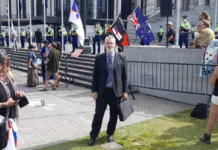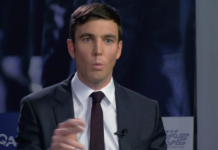
UNTIL THIS MORNING, the Operation Burnham Inquiry (OBI) faced an oncoming avalanche of criticism which seemed certain to bury its final report in public disfavour. From the very beginning, the conduct of the Inquiry has been called into question, and the Inquiry heads, Sir Terrance Arnold and Sir Geoffrey Palmer dismissed as the Crown’s diligent defenders.
In both journalistic and satirical mode, I, too, have joined in this blackguarding of the OBI. Like so many others on the Left, I was convinced that its secrecy-shrouded deliberations could not possibly be trusted to deliver a truthful rendering of Operation Burnham and its consequences.
That changed this morning, when one of the authors of Hit & Run, Jon Stephenson, in an article for Stuff, and again on RNZ’s Morning Report, informed New Zealand that he and his co-author, Nicky Hager, had erred in declaring that no Taliban insurgents were present in Naik, the village attacked by New Zealand SAS troopers, supported by US helicopter gunships, during Operation Burnham.
Two years of painstaking and highly dangerous research on the ground in Afghanistan had led Stephenson to at least two Taliban insurgents who had been taking refuge in one of the mountain villages targeted by the NZSAS. These fighters freely admitted that they had, as the NZ Defence Force always insisted, participated in the attack that killed the New Zealand infantry officer, Lieutenant Tim O’Connell, three weeks earlier.
This new information has the potential to dramatically shift the public’s perceptions of Operation Burnham. In essence, it admits into what has been a highly polarised public debate concerning the events of the night of 21-22 October 2010, a measure of the confusion and uncertainty that inevitably accompany all such military operations.
Those who insist that the raid killed 6 civilians and injured 15 more will not be moved; nor will those who are adamant that the NZDF killed 9 Taliban insurgents. But, for the vast majority of New Zealanders, who fall somewhere between these two extremes, Stephenson’s correction of his own, and Hager’s, original story will transform the whole event into something much more opaque. As of this morning, the black and white certainty of Hager, and the villagers’ lawyer, Deborah Manning, will be overwhelmed by fifty different shades of sceptical grey.
Stephenson’s refusal to condemn the OBI, its chiefs, Arnold and Palmer, or the investigative work its staff have undertaken, will also give a great many hitherto critical observers, like myself, serious pause. If a journalist of Stephenson’s standing feels comfortable in talking about the “mana” of the Inquiry, then perhaps there is hope that it will not present New Zealanders with the highly redacted “whitewash” its critics have consistently predicted.
Certainly, Stephenson’s latest revelations offer the OBI the opportunity to take up a position midway between the claims of the NZDF, and the account of the operation represented on the pages of Hit & Run. Clearly, the intelligence supplied to the International Security Assistance Force (ISAF) in which the killers of Lieutenant O’Connell were said to be hiding in the Tirgiran Valley, was correct. It is also clear, from the testimony gathered by Stephenson, that these fighters were being sheltered in the village of Naik. On the other hand, it is equally clear that ISAF’s American helicopter gunships, in attempting to kill the Taliban insurgents, inadvertently killed and injured a number of Afghan civilians.
In answering the obvious question: Why didn’t the NZDF admit that these civilian deaths had occurred?; it seems highly probable that Arnold and Palmer will be obliged to deliver a judgement highly critical of the NZDF’s conduct subsequent to the Operation Burnham raid.
Even more uncomfortably, if the NZDF’s obfuscation turns out to have been inspired by American sensitivities regarding the part played by their helicopter gunship/s (and its/their supposedly defective gunsight/s) in killing Tirgiran villagers, then the painfully restored relationship between New Zealand and its “very, very, good” American friends will come under strain. If any sections of the OBI report end up being heavily redacted, it will be those relating to the interactions between the NZ forces on the ground in the Tirgiran Valley, and the US forces hovering above it.
Included in that redaction will, almost certainly, be the US helicopter’s on-board video recording of the action. Judging from the invaluable testimony obtained from the Taliban insurgents by Stephenson, that video may well include a sequence showing the gunship’s pursuit of the fleeing fighters, along with the gunning-down of the Tirgiran villagers fleeing with them. That sequence, by proving both sides correct, is crucial. We may not get to see it, but it is reasonable to anticipate the withheld videotape playing a major part in Arnold’s and Palmer’s final judgement of the tragedy that was Operation Burnham.
What they will have observed in the video is know as “the fog of war”: a phenomenon as old as human conflict itself. Its depiction of the confusion and lack of information that almost immediately overwhelms any military operation will communicate all that anyone can, or should, know about the NZDF’s honourable, but botched, attempt to avenge a fallen comrade; and the unintended civilian deaths and injuries for which some unknown NZSAS trooper/s, and airborne American machine-gunner/s, are responsible.





Hey, well. If the government wants to know what beneficiaries get up to in the bedroom. Then I want to know what the government got up to in Afgahnistan. Y’know? What’s good for the goose is good for the gander. And of course parliament should be held to higher standards, correct? Eh, so release the video.
You eat that shit sandwich with a nosepeg and a blindfold on then u sack of shit
Do you think we haven’t seen the 50 yard yarn before?
To qualify as a yarn of any dimensions, you would need to establish 1) that the NZDF set out to deliberately kill Afghan civilians, and 2) that Jon Stephenson is lying. Not easy. A much easier task would be to establish that the NZDF went to great pains to cover-up the events of 21-22 October 2010.
Yes, to date we’ve seen a lot of accusations from Mr Hager of a “cover-up” and a “conspiracy” but thus far not a single piece of evidence to support this notion… It will be fascinating if the Inquiry indeed finds anything, or if Mr Hager’s pronouncements turn out to be hollow?
Your accent reads as centre right leaning with a little bit of anger. I could be wrong that’s just my impression of your comments on this blog.
Chief of the Defence Forces from Jerry Mateparae to Jones and Keating was always managing and softening the public up for a big reveal. Standard SAS operating procedure (and Mateparae and Keating are former commanders of the SAS) is to always have an exit plan.
They were planning a big reveal anyway, in small increments so the public had time to adjust to allegations of war crimes.
So if this was all planed then the public should be less outraged.
But if it wasn’t planned then the public will be significantly more outraged.
Hi Sam – I’m certainly not angry, must just be my stilted writing style. I’ve tried to view the detail provided from both sides, and it leads me to think there are huge problems with the book Hit and Run.
Hope you don’t mind how Iv laid out my reply, moving right along.
A culture of evil exists when we play these freaky games that say well, Niki Hager and Jon Stephenson aren’t that good at journalism because there timeline of children being ended in extrajudicial murder isn’t, well isn’t perfect.
The Defence Forces Chiefs had very convoluted plans. We know how they planned because NZDF pressers was on the television for everyone to see.
But the plan wasn’t convoluted for the sake of being convoluted.
What successive Defence Force Chiefs was doing with Hager and Stephenson was playing this game of chess with them where the Defende Chiefs had all the information.
So the defence Chiefs could think 10 moves ahead while Hager and Jon could only think 5 moves ahead.
No matter how convoluted the the information surrounding these extrajudicial murders can only make sense of the Defence Force Chiefs was playing a very deep game.
It’s incredibly infuriating having your major pieces who are incredibly smart move against pawns for the sake of finding some guts.
“botched, attempt to avenge a fallen comrade”
There’s the problem. The raid was driven by the desire for revenge. The NZDF liked to think it was in Afghanistan for a peace keeping role. Naturally, the Taliban instead saw them as the enemy. The New Zealand felt themselves unjustifiably targeted, when in fact they were armed combatants in a theatre of war. If the NZDF had not tried to seek revenge, this would never have happened.
The NZDF has publicly said it has passed over hours of video footage of the whole operation to the good judges. They have also said they’ve passed over intelligence gathered in the days and weeks after the operation. I suspect all of this is the evidence they have relied upon for saying those killed were all insurgents (and not civilians). Perhaps we need to be ready for the possibility that the military version of events will be confirmed by the Inquiry, and that it is not the soldiers that have erred, but the activists who sought to use this operation for their political ends?
Crikey, unfortunately there was more than one event, and there was more than one visit to more than one village. There was a series of happenings and non-happenings.
Sorry Snow White, but definitely only one village (with specific geo-special references also likely to have been supplied to the Inquiry with the other definitive evidence)… expect the good judges to also clarify that the book also botched something as simple as “where”!
The death of the school teacher cannot be accounted for by the American chopper….As lead in the operation, the NZDF had the opportunity to match so called insurgents against legitimate civilians killed and wounded, on the night and the coming days after the series of incidents. The NZDF then had the opportunity to have put their hand up and admit the facts as they happened at the time that they had happened. Necessary humanitarian aide, compensation for those wrongfully killed, and a timely public apology should have been forthcoming at the time. The consequence however of the NZ public having become aware of the operation going wrong would have lead to an increased pressure from the NZ public for NZ to withdraw from the conflict in this zone. I am saddened by the NZDF’s inaction over such a long period of time and the lack of transparency that has been shown after several attempts in the past to have these matters addressed way earlier.
The problem with your assessment is that it isn’t based on the known facts. There is nothing to suggest anything in this operation was “botched” but the claims by Mr Hager that it must have been. Military enter a village, look for insurgent leaders, they are not there, a number of insurgents who are seen arming themselves (including with RPG) and taking up offensive positions are killed by helicopters gun fire, and the patrol leaves. No botch there. Then you’ve got two stray bullets that hit the roof of a house. But there is no claim by the villagers that this house contained villagers or that this is how any villagers were killed, None the less, Nato say “civilian casualties were possible” from this event. We await the judges weighing up the villagers/Hager accounts, with the video evidence. I know which of the two my money is on!
Comments are closed.